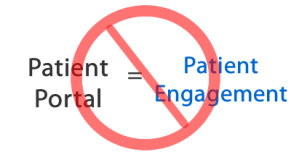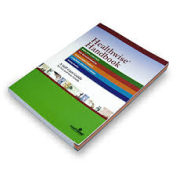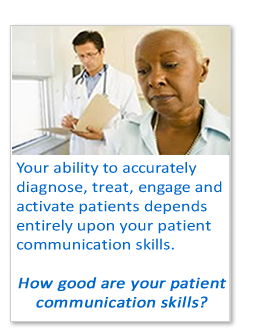… We Walk Into The Exam Room At The Doctor’s Office.
 We all play many roles in life …. spouse, employee, sibling, parent, friend, customer, and so on. Each of these roles brings with it its’ own unique set of expectations (self-imposed as well as externally imposed – can you say spouse) for how we are supposed to think and behave. One role that we all play is that of “being a patient.”
We all play many roles in life …. spouse, employee, sibling, parent, friend, customer, and so on. Each of these roles brings with it its’ own unique set of expectations (self-imposed as well as externally imposed – can you say spouse) for how we are supposed to think and behave. One role that we all play is that of “being a patient.”
The roles and behavioral dynamics that take place in the exam room between patients and physicians gets little attention today. But they should, since the exam room is where diagnoses are made, treatment plans formulated and utilization of health care resources determined. And if outcomes are any evidence, what passes for patient communications these days, and the resulting patient behavior, is anything but patient-centered or high quality.
The Patient’s Role
Beginning with our childhood visits to the pediatrician with our mother, we have all been socialized into the “patient role.” We come seeking the doctor’s expertise. We are petitioners. Our role as patient is straightforward … answer the doctors questions … sit passively by while the doctor does their thing … and upon leaving the office, do what the doctor recommends. Doctors after all know what is in our best interest. Right?
If you do what you were told (recommended) then you care a good patient – compliant and engaged are words that clinicians often associate with good patients. If you challenge the doctor by making requests, taking up too much time, or you do not do what the doctor recommends – you are a often considered a difficult, noncompliant patient.
From the patient’s perspective, good patients get the best care … but if you are a bad patient you may not get the doctor’s full attention … or worse you could be “fired.”
The Doctor’s Role
Doctors too have a role … that of clinical expert. Many physicians will tell you that they were taught 2 things in medical school : 1) how to diagnose medical problems and 2) how to treat medical problems. To the extent that most doctors talk to you … it is for those two purposes alone. Most doctors will tell you they were never taught in medical school to get to know the patient (or person). They will also tell you they often wish patients would “shut up” after they have the information they need to arrive at a working diagnosis.
 To do their job, physicians were taught the need to control the visit by the way they communicated with patients. Traditionally, physicians learned by watching their medical school preceptors and mentors that the way to “control the visit” was to control who the communications between they and their patients. This “physician-directed” (aka paternalistic) communication style is where the physician does most of the talking, asks most of the questions ( usually closed ended) and makes most if not all the decisions.
To do their job, physicians were taught the need to control the visit by the way they communicated with patients. Traditionally, physicians learned by watching their medical school preceptors and mentors that the way to “control the visit” was to control who the communications between they and their patients. This “physician-directed” (aka paternalistic) communication style is where the physician does most of the talking, asks most of the questions ( usually closed ended) and makes most if not all the decisions.
Here’s a comment I received recently for a decidedly Physician-Directed (Paternalistic Physician) that illustrates their role mindset: An estimated 70% of practicing physicians today employ a “Physician-Directed” style when talking with patients.
 Over the last 20 years, there has been a resurgence in the importance of understanding and treating the whole person … and not just their medical problems. This has lead to what is commonly referred to as Patient-Centered Care.
Over the last 20 years, there has been a resurgence in the importance of understanding and treating the whole person … and not just their medical problems. This has lead to what is commonly referred to as Patient-Centered Care.
A patient-centered style of communications seeks to actively involve patients in the medical exam. The focus is not just on the biomedical aspects of the patient’s disease … but also how patient perceive their health issues, their ideas as to it cause as well as its treatment. It simply means that the clinician ask them for their thoughts as a way of making a better diagnosis and arriving at a better treatment plan. One they both can agree upon. A Patient-Centered style also focuses on patient psychosocial issues which are all but ignored by the Physician-Directed style.
Note : Nothing about a Patient-Centered Style suggests that physicians give patients anything they want even if they don’t need it. It means that if patients asks for something they don’t need, the clinician seeks to understand the reason for the patient request. And if unnecessary, the clinician gives the patient the courtesy and respect of explaining why they think the request is inappropriate.
Implications Of Roles and Communication Styles
Now you need to ask yourself the following questions
If 7 out of 10 physicians, including those in your provider networks, do not know how to “speak Patient-Centered”, how can you expect them to do the following:
Engage patients – How engaging is it when you doctor interrupts you, ignores or dismisses your input, or limits the number of questions you can ask …and information you receive?
Be Empathetic – If your doctors see no point in eliciting patient psychosocial issues … what makes you think you can they are doing it?
Shared Decision-Making – If you doctors just assume that patients want/expect them to make the decisions why in the world would you expect them to ask the patient what they think? They don’t solicit the patient’s input about anything else?
Missed Patient Engagement Opportunities – The average patient presents from 9 to 12 patient engagement opportunities at each visit. Most doctors miss more than 50% of these opportunities. not because they lack the time…but because their either don’t recognize them as opportunities, don’t know how to respond or simply ignore them. That comes out to almost 100 missed patient engagement opportunities per doctor per day. Remind me what the cost of an unnecessary ER visit or hospital readmission is again?
So What’s The Solution?
Hospitals, ACOs, Medical Groups and Health Plans should work with physicians in their provider networks to do the following:
- Commit to adopting patient-centered communication best practices – they do exist, there are 30+ years and hundreds of published studies linking patient centered communications to increased patient engagement, better outcomes, lower costs and better patient experiences.
- Profile and benchmark your physicians’ patient communication and engagement skills against established best practices. Audit how many patient engagement opportunities are being missed by physicians in your provider network and at what cost.
- Conduct patient communication and engagement skills training programs tailored to the individual needs of your physicians.
Stephen Wilkins, MPH, Principal
Mind the Gap Academy
http://www.mindthegapacademy.com
Conflict of Interest: My company works with hospitals, ACOs and Medical Groups to assess and benchmark physicians’ patient communication and engagement skills. We also offer online physician training in patient-centered communications and engagement.
Sources:
Roter, D. L., Stewart, M., Putnam, S. M., Stiles, W., & Inui, T. S. (1997). Communication Patterns of Primary Care Physicians. JAMA (277), 350-356.
Joseph-williams, N., Elwyn, G., & Edwards, A. (2013). Knowledge is not power for patients : A systematic review and thematic synthesis of patient-reported barriers and facilitators to shared decision making. Patient Education and Counseling.
Levinson, W., Stiles, W. B., Inui, T. S., & Engle, R. (1993). Physician Frustration in Communicating with Patients. Medical Care, 31(4), 285-295.
Alexander, J. a, Hearld, L. R., Mittler, J. N., & Harvey, J. (2012). Patient-physician role relationships and patient activation among individuals with chronic illness. Health services research, 47(3 Pt 1), 1201-23.
Levinson, W. (2011). Patient-centred communication : a sophisticated procedure. BMJ Quality And Safety, 20(10), 823-826. doi:10.1136/bmjqs-2011-000323

 In a
In a 



 the ends justify the means. In other words, the fact that physicians are busy justifies in the apologist’ mind physicians cutting corners when it comes to something as seemingly unimportant as “talking with patients.”
the ends justify the means. In other words, the fact that physicians are busy justifies in the apologist’ mind physicians cutting corners when it comes to something as seemingly unimportant as “talking with patients.”